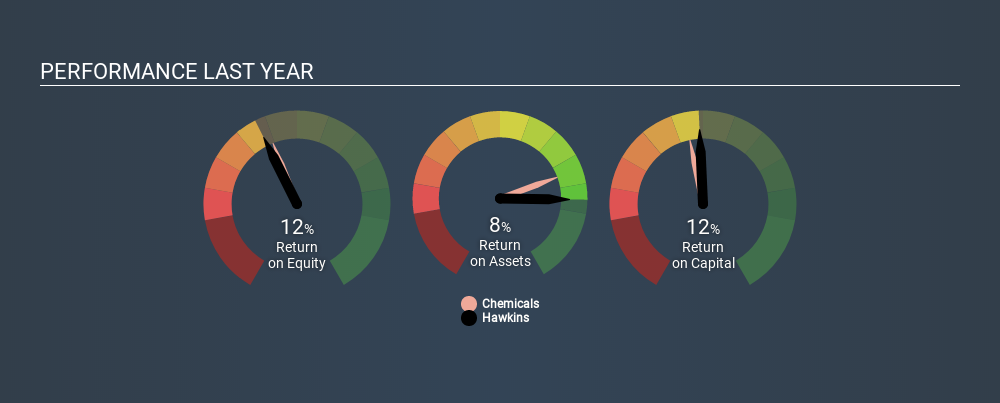
Today we are going to look at Hawkins, Inc. (NASDAQ:HWKN) to see whether it might be an attractive investment prospect. Specifically, we're going to calculate its Return On Capital Employed (ROCE), in the hopes of getting some insight into the business.
First of all, we'll work out how to calculate ROCE. Then we'll compare its ROCE to similar companies. Last but not least, we'll look at what impact its current liabilities have on its ROCE.
Understanding Return On Capital Employed (ROCE)
ROCE measures the 'return' (pre-tax profit) a company generates from capital employed in its business. Generally speaking a higher ROCE is better. Overall, it is a valuable metric that has its flaws. Renowned investment researcher Michael Mauboussin has suggested that a high ROCE can indicate that 'one dollar invested in the company generates value of more than one dollar'.
So, How Do We Calculate ROCE?
Analysts use this formula to calculate return on capital employed:
Return on Capital Employed = Earnings Before Interest and Tax (EBIT) ÷ (Total Assets - Current Liabilities)
Or for Hawkins:
0.12 = US$40m ÷ (US$393m - US$54m) (Based on the trailing twelve months to September 2019.)
So, Hawkins has an ROCE of 12%.
See our latest analysis for Hawkins
Does Hawkins Have A Good ROCE?
ROCE can be useful when making comparisons, such as between similar companies. Using our data, we find that Hawkins's ROCE is meaningfully better than the 9.6% average in the Chemicals industry. I think that's good to see, since it implies the company is better than other companies at making the most of its capital. Independently of how Hawkins compares to its industry, its ROCE in absolute terms appears decent, and the company may be worthy of closer investigation.
You can see in the image below how Hawkins's ROCE compares to its industry. Click to see more on past growth.

When considering this metric, keep in mind that it is backwards looking, and not necessarily predictive. ROCE can be misleading for companies in cyclical industries, with returns looking impressive during the boom times, but very weak during the busts. ROCE is only a point-in-time measure. If Hawkins is cyclical, it could make sense to check out this free graph of past earnings, revenue and cash flow.
How Hawkins's Current Liabilities Impact Its ROCE
Current liabilities include invoices, such as supplier payments, short-term debt, or a tax bill, that need to be paid within 12 months. Due to the way the ROCE equation works, having large bills due in the near term can make it look as though a company has less capital employed, and thus a higher ROCE than usual. To counteract this, we check if a company has high current liabilities, relative to its total assets.
Hawkins has current liabilities of US$54m and total assets of US$393m. Therefore its current liabilities are equivalent to approximately 14% of its total assets. Current liabilities are minimal, limiting the impact on ROCE.
The Bottom Line On Hawkins's ROCE
This is good to see, and with a sound ROCE, Hawkins could be worth a closer look. Hawkins looks strong on this analysis, but there are plenty of other companies that could be a good opportunity . Here is a free list of companies growing earnings rapidly.
If you are like me, then you will not want to miss this free list of growing companies that insiders are buying.
If you spot an error that warrants correction, please contact the editor at editorial-team@simplywallst.com. This article by Simply Wall St is general in nature. It does not constitute a recommendation to buy or sell any stock, and does not take account of your objectives, or your financial situation. Simply Wall St has no position in the stocks mentioned.
We aim to bring you long-term focused research analysis driven by fundamental data. Note that our analysis may not factor in the latest price-sensitive company announcements or qualitative material. Thank you for reading.
About NasdaqGS:HWKN
Hawkins
Operates as a specialty chemical and ingredients company in the United States.
Flawless balance sheet with proven track record.
Similar Companies
Market Insights
Community Narratives



